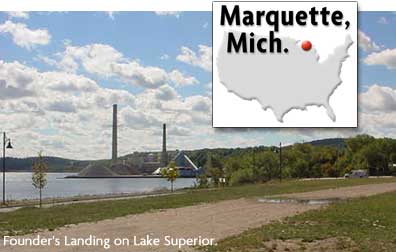|
COVER STORY | IN
THE NEWS | STAGE
MATTERS March 16, 2006
Above: Marquette, Mich., illustrated plans for waterfront development.
To step into it on a soggy winter morning is to step into a landscape of chaos. Here and there, throughout the 38-acre site, great mysterious mounds of dirt poke up from the plain, like buried Mayan ruins awaiting an archaeologist. The southwest corner of the site, bordering a Sierra Pacific mill, is an expansive mud field flecked through with wood chips. Trash is everywhere. Clark Slough, an extension of the bay, runs through the site. It's so choked with garbage that, in places, it's difficult to see water beneath tossed backpacks, Styrofoam cups, and dead 40-ounce beer bottles that have been there so long that the color has faded from the caps. Nearby, homeless men have built cave-like shelters in a large stack of rotten logs and debris. Giant stands of fennel have conquered large portions of the land. Dig down into the earth, put samples beneath a microscope, and on the molecular level the Balloon Track is just as messy. Once the city's most important industrial site, the center of its transportation infrastructure, the property has absorbed some nasty chemicals over the years. It used to be northwestern California's main rail yard (the parcel gets its name from the balloon-shaped turnaround track that used to grace it), and years of petroleum, diesel and grease -- to say nothing of lead and other heavy metals -- have worked their way into the soil. Now, Rob and Cherie Arkley, Eureka's richest citizens, have gained control of the property and have presented residents with plans for a development they call "Marina Center," which would be anchored by another big box or two--a Home Depot and possibly Best Buy. When Wal-Mart was pitching its plans, the city divided into two camps, each of which battered the other mercilessly. Suspicion, fear, and invective reigned. The national news came to town to cover the fight. Now, the two camps are forming once again, each with the requisite web sites, four-color literature and passionate spokespeople. Here we go again -- but is this a journey we have to take? In its heyday, the Balloon Track was the nerve center of the region's economy. It linked Humboldt County to the outside world, to hundreds and thousands of other cities around California and the United States, many of which had their own central rail yards. In the years that followed, as cities grew outward and old industries faded along with the once-mighty railroads, many of them were left with Eureka's problem: a vacant parcel of land, often soaked through with petroleum and other nasty chemicals, that had the potential to become prime real estate. Last week, the city of Sacramento lifted the curtain on what is being called "the largest infill development project west of the Mississippi" -- a master plan aimed at reclaiming an abandoned 250-acre rail yard which, when built out, will essentially double the size of that city's downtown. Salt Lake City's rail yard redevelopment project was a showcase project when that city hosted the Winter Olympics in 2002. Santa Fe, Milwaukee, and Portland (Maine) are also among the numerous large American cities looking at ways to make use of old rail land. But it's not just large cities that are looking for creative ways to fill the holes left by railroad downsizing. There are plenty of places the size of Eureka that are using them to build and expand in meaningful ways. And a lot of them are doing a better, and smarter job, than we are.
"There was this big vacant site adjacent to our downtown," said Lashbrook, who has a degree in natural resource planning from Humboldt State. "So in 1995, we went through this really elaborate public process of looking at the alternatives. There was a lot of skepticism at the time. People said `Nothing's ever going to happen with that site -- it's too toxic, or the railroad's never going to sell it.'" But the skeptics were gradually won over. The city
netted a $350,000 "Sustainable Communities" grant from
the California Pollution Control financing authority. The money
was used to finance a variety of analyses of the site including
a traffic study and a study of market conditions. The city retained
an architectural consultant to explore wha When the city's plans came together, it went out and recruited a developer to build for them -- Bay Area developer Rick Holliday, who is also working on a rail yard conversion project near downtown Oakland. When Holliday was brought on board, the Union Pacific, which had previously been reluctant to deal, agreed to look at moving its railroad facilities somewhere down the line. Holliday took over title of the property just a few weeks ago. The final master plan for development is being formally presented to city residents this week. But Denyelle Nishimori, a city planner, last week gave a broad picture of what it will include, and its scope is stunning. The project will add about 100,000 square feet of office space, 72,500 square feet of retail space, 9,000 square feet of restaurants, a 12,000 square-foot museum, a 1,200-seat movie theater, and 400 residential units--all in about 600,000 square feet of total built space, an area smaller than Eureka has available to it. (Nishimori notes that none of the retail will include a store larger than Whole Foods or Trader Joe's -- no big boxes. "We would flip out over that," she said). Most of the development will follow "New Urbanist" guidelines. It'll have small, pedestrian-friendly streets, and most of the housing will be located on the second floor, above retail or office firms. Most all the buildings will be three stories tall, Nishimori said. Holliday said that he was grateful that the city had done a good deal of the heavy lifting in designing the plan. "I would not have pursued this project had that not been the case," he said. "I have a second home up there, and I don't think it's a good idea to do a major redevelopment project where you want to relax. The town's goal had been to do the studies and get the impediments out of the way, so a developer could show up. "It's a very involved community, and it seems like we've been able to strike some consensus around a really interesting plan. As you look at the political winds that have been blowing through development in the last five years, none of those people seem to have issues with it." The city has planned well, but it may have also lucked out. Despite having played host to a fiberboard mill in addition to rail operations, Holliday estimates that environmental clean-up of the site will only cost somewhere between $500,000 and $1.5 million.
Situated on the west bank of the Mississippi River, Clinton (pop. 27,000) is still a very muscular industrial town. Archer Daniels Midland, the agricultural giant and the largest employer in town, is putting half a billion dollars into expanding its plant on the edge of the city. According to Steve Ames, president of the Clinton Area Development Corp., 12 companies in the Fortune 500 have major operations in the city. Money for new industry is still pouring in; two large-scale biodiesel manufacturers plan to open plants there soon. At the same time, though, the city is trying to get a handle on the visual blight that so often plagues industrial towns. The keystone of this effort is a plan to redevelop a 250-acre brownfield zone surrounding a 38-acre former rail yard, a project known as "Liberty Square." Highway 30, the city's major east-west thoroughfare, passes through the area, and planners hope the new development will present a better face to people traveling through. When Mayor Wynn, who is currently in her third term, was first elected, the city government was just beginning to look into redeveloping the area. That's when she realized the size of the task it was facing: first the old rail yard and other properties would have to be acquired, then a vast amount of environmental clean-up would have to take place. To that end, Wynn instituted something she called a "Mayor's Summit" -- a yearly trip to Washington, D.C. by mayors from little cities around Clinton on both the Iowa and Illinois sides of the Mississippi to lobby Congress for funds targeting their region. The annual trip has been a vast success; Wynn estimates it has garnered some $30 million in federal funds for the region in the last six years. A large amount of that money has been devoted to the Liberty Square project. In total, the city has secured some $1.1 million in state and federal environmental funds for the clean-up of the area. With the Union Pacific as an active partner, the city should be able to eliminate the most serious of the area's toxic threats. Then it will be able to use the $13 million in transportation funds that Congress awarded Clinton last year to finance new construction at the site. The new development won't change the industrial character of the town. "The idea of having retail -- your bouquet and chocolate shops -- is probably not going to fly too far, if you're right next to a plant that smells like hog rendering," City Engineer Steve Honse said, referring to the ADM plant, which is located just across from the project. Still, improving the traffic flow through the town, cleaning up pollution and removing junked, abandoned buildings is expected to go a long way toward bettering the city's image. "It's going to make the area much more attractive," said Ames, whose job it is to promote economic development in the city. "You bring in a client, and the first question they have is where they can find a place to locate. The second is, what is the quality of life and what kind of labor force is available?" The rail yard project and the larger effort to transform Liberty Square, he said, should play a big part in improving both.
Pat Gruber, the city's planning and zoning official, said earlier this month that redevelopment of the city's 29-acre "South Rail Yard," located right on the shore of Lake Superior, has been a priority for many years. They've made a lot of progress -- the city finally acquired the yard from the Wisconsin Central in June 2002, with the help of a $1.1 million grant from the state -- but there's a lot more yet to be done. "It's been a long road, somewhat controversial," Gruber said. "We really don't have a whole lot down there yet, apart from extending and putting in a bike path." The city wants a development that includes single-family residential development, along with some retail and plenty of open space, but despite pressures to develop prime waterfront property quickly the planning commission is not afraid to be picky. Marquette would prefer to get things done right than done quickly, Gruber said, and it has already scrapped the first round of plans for the site. "They were looking for some award-winning architecture," Gruber said. "The original proposal was sort of ho-hum, cookie cutter. [The developer] had a little strip mall he was proposing that could have fit anywhere." Gruber said that the city is considering making a "pattern book" for prospective developers, something that would give them a clearer idea of what the city wants to see, preferably something made with the distinctive sandstone found in the area. "They want some place where people could come and look and feel the excitement of the waterfront." Though the city has sent part of the project, which it has christened "Founder's Landing," back to square one, other parts are going forward great guns. Gary Kropp, a native son who now lives in Milwaukee, has received the city's enthusiastic approval for an ambitious reimagining of a rail-related facility unique to the Great Lakes area -- a massive 950-foot long former ore dock that juts out into Lake Superior. When iron mining was still king, the ore dock was exceedingly important to the town. Railcars would deliver huge quantities of raw iron to the dock, there to unload their freight onto the great ore ships that plied the lakes. But an all-out mining blitz during World War II depleted much of the local ore, and while iron is still an important industry, it is no longer the powerhouse it once was. The ore dock has stood idle for years. Kropp proposed to turn the dock, which is solidly anchored into the bedrock beneath the lake, into a public promenade surrounded by the water. In the center of the dock, anchoring the project would be a large-scale development that would include high-end shops and condominiums. The plan, which still requires some permitting issues to be cleared away at the state level, has the strong backing of the city and its residents, Gruber said, because it simultaneously creates new public space and new housing while preserving an important part of the city's past. Kropp said last week that he feels honored to be part of the project. "It's nice to see what's happening in my old home town, and it's a gas to be part of it," he said. "People are very protective of the South Rail Yards. They're being really good about being watchdogs -- the city and the citizens. And I have a lot of respect for that." Each of these cities, Truckee, Clinton and Marquette, has a unique vision of what it wants to do. But they all have at least one thing in common: In each case, city government took charge of the planning process and never let go. As a result, the projects are sailing through with minimal controversy. The planning of the projects, and the strategies for dealing with pollution and other obstacles, are being addressed to most everyone's satisfaction. In the wake of the Wal-Mart debacle, Eureka had started down a similar road. The city applied for and received a $50,000 grant from the county's Headwaters Fund, and planned to match that sum with money from its redevelopment agencies. The money would have funded a study aimed at identifying state and federal grant money that could have been used to clean up the Balloon Track and to develop, through a series of community meetings, ideas for development that had the broad support of the citizenry. But, in late 2004, after the Arkley family privately made it known to members of the City Council that it was in negotiations to purchase the property, the city abruptly changed course. The grant from the Headwaters Fund was returned and the study abandoned. Councilmember Jeff Leonard, who introduced the motion to abandon the study (to much confusion, at the time), later said that he feared that it might ruin the city's best chance to get the Balloon Track developed. This may prove to be a mistake. (And ironically, not its first: Arkley offered to donate money to buy the parcel for the city back in 2001. The council turned down the offer, saying that it did not want to assume liability for the site's pollution problems.) Though powerful, the Arkley family is not omnipotent, and it's now facing serious opposition on two fronts, either one of which could untrack the project. An environmental group, Humboldt Baykeeper, is on the verge of filing a lawsuit aimed at forcing Union Pacific, before it transfers title to the Balloon Track, to clean up the property. That would effectively preempt the Arkleys' proposed solution to contamination at the site, which is to "cap" it -- to essentially asphalt over the entire surface of the property. It would also add months if not years of delay in the path of any redevelopment plan. Baykeeper says that water samples it has taken from Clark Slough show levels of lead 10 times the allowable limit, and alleges that the railroad company has not adequately complied with monitoring and clean-up orders issued by the North Coast Regional Water Quality Control Board, a state agency charged with enforcing federal clean water standards. "The problem is that we know that the groundwater underneath the site is in direct communication with Humboldt Bay," said Baykeeper's Pete Nichols last week. "Capping the property with a parking lot won't solve the problem." Meanwhile, a fairly wide coalition of citizens -- ruralists, Old Town merchants and established businesses that would be affected by a new Home Depot -- is gathering to oppose the development on the same grounds that brought down Wal-Mart: That big box retail would be bad for the local economy and would sap Eureka of its distinctive character. They will oppose the development on political grounds, and they have two chances to make their voices heard. Two agencies control the zoning of the Balloon Track: Eureka City Council and, because it lies near the bay, the state Coastal Commission. Currently, the parcel is zoned for "public use only," meaning that, as it stands, only public facitilies -- parks, schools, municipal buildings and the like -- can be built there. If "Marina Center" is to go forward, both agencies will have to agree to change the Balloon Track's zoning. Despite its generally supportive record on Arkley projects, the City Council approval is not a sure thing. The developers are hoping for a vote right around the June elections, when three of the five council members' seats will be up for grabs. If the council does approve the zoning change, developers will have to seek the blessing of the Coastal Commission. That could be an even tougher nut. According to one well-placed source inside the agency, the commission will want to be assured that thought was put into developing alternative visions for the site. Since the city has abandoned the earlier study, which would have done just that, it may have a difficult time convincing the commission that all options had been thoroughly explored. That leaves only two alternatives on the table: a controversial and divisive development, sure to inspire antipathy for many years to come; or yet more of the Balloon Track as it exists, a dead zone at the heart of the city. Other places did things differently. They have been creative and brave. They did all they could to expand the range of possibility, not to limit it. If the "Marina Center" development is derailed, perhaps we will still be able to learn from their example. If not, we can only look at them longingly. That train has already left the station.
COVER
STORY | IN
THE NEWS | STAGE
MATTERS Comments? Write a letter! © Copyright 2006, North Coast Journal, Inc. |

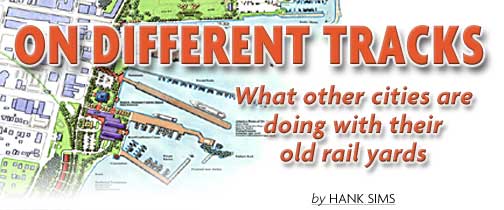

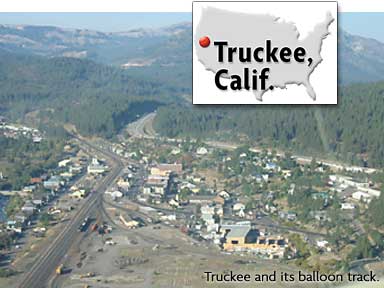 Other cities have taken charge
of their fates. Despite its
long and colorful history, the booming high Sierra town of Truckee
(pop. 16,000) was actually incorporated less than 20 years ago.
One of the big reasons it did so, according to Tony Lashbrook,
the city's director of community development services, was that
citizens of the town -- which lies just off Interstate 80 near
the California-Nevada border -- wanted to control the development
of a 32-acre rail yard (which Truckee residents also refer to
as "the Balloon Track") located smack in the center
of their city. Planning for the site, which the Union Pacific
still uses, was one of the newly chartered city's first priorities.
Other cities have taken charge
of their fates. Despite its
long and colorful history, the booming high Sierra town of Truckee
(pop. 16,000) was actually incorporated less than 20 years ago.
One of the big reasons it did so, according to Tony Lashbrook,
the city's director of community development services, was that
citizens of the town -- which lies just off Interstate 80 near
the California-Nevada border -- wanted to control the development
of a 32-acre rail yard (which Truckee residents also refer to
as "the Balloon Track") located smack in the center
of their city. Planning for the site, which the Union Pacific
still uses, was one of the newly chartered city's first priorities.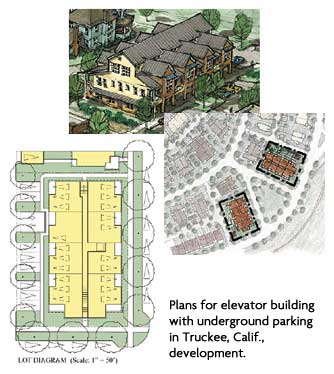 t
types of buildings should be placed on the site. Throughout,
the city met with major stakeholders, including downtown merchants
and an environmental organization, the Truckee River Watershed
Council.
t
types of buildings should be placed on the site. Throughout,
the city met with major stakeholders, including downtown merchants
and an environmental organization, the Truckee River Watershed
Council.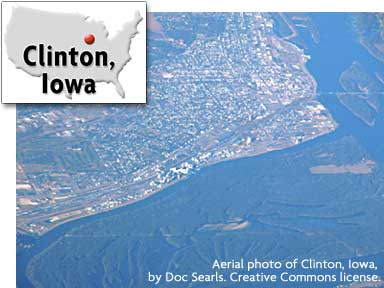 Other cities have asked for
help."When I became mayor, I knew nothing about
city government," said LaMetta Wynn, mayor of Clinton, Iowa,
last week. "And I told people that. But I said, `I do know
about leadership, and I think you need a leader.' When I got
here, the first thing I discovered is we need more money."
Other cities have asked for
help."When I became mayor, I knew nothing about
city government," said LaMetta Wynn, mayor of Clinton, Iowa,
last week. "And I told people that. But I said, `I do know
about leadership, and I think you need a leader.' When I got
here, the first thing I discovered is we need more money."